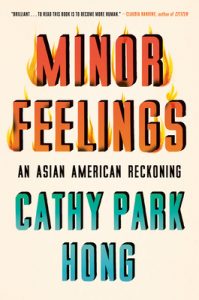 It was uncanny. I don’t know if it was just that I happened to be stumbling on all these titles around the same time or that reading one revealed the roads to the others: Romance and the “Yellow Peril”: Race, Sex and Discursive Strategies in Hollywood Fiction by Gina Marchetti, Curry: Eating, Reading and Race by Naben Ruthnum, Minor Feelings by Cathy Park Hong, Know My Name by Chanel Miller. Somewhere between Minor Feelings and Know My Name, I had a conversation where I mentioned how I’d read a picture book at the library sometime around first or second grade that talked about the Chinese head tax (my memory produced the number $500, which, surprisingly, proved accurate, and if that doesn’t strike you as a large sum, think about inflation: using the Bank of Canada inflation calculator going back as far as they are able (1914) to now, that $500 would amount to $11,575 now) and the dangerous work Chinese labourers did for railroad construction. Someone asked what the Chinese head tax was, which got me thinking whether I’d learned anything about it in school, whether I’d encountered this information at all after that picture book, which I’ve not been able to find since; there’s a lot we don’t learn in Canadian history classes, isn’t there?
It was uncanny. I don’t know if it was just that I happened to be stumbling on all these titles around the same time or that reading one revealed the roads to the others: Romance and the “Yellow Peril”: Race, Sex and Discursive Strategies in Hollywood Fiction by Gina Marchetti, Curry: Eating, Reading and Race by Naben Ruthnum, Minor Feelings by Cathy Park Hong, Know My Name by Chanel Miller. Somewhere between Minor Feelings and Know My Name, I had a conversation where I mentioned how I’d read a picture book at the library sometime around first or second grade that talked about the Chinese head tax (my memory produced the number $500, which, surprisingly, proved accurate, and if that doesn’t strike you as a large sum, think about inflation: using the Bank of Canada inflation calculator going back as far as they are able (1914) to now, that $500 would amount to $11,575 now) and the dangerous work Chinese labourers did for railroad construction. Someone asked what the Chinese head tax was, which got me thinking whether I’d learned anything about it in school, whether I’d encountered this information at all after that picture book, which I’ve not been able to find since; there’s a lot we don’t learn in Canadian history classes, isn’t there?
Shortly after that conversation, the shooting in Atlanta. Shortly before that, Half Baked Harvest’s inauthentic pho incident and why it matters (I’ve also discussed food and cultural appropriation before here, but Rebecca Du has presented the case very thoroughly, including information about what the issue is here, how Teagan could’ve handled it better, and what reparations might look like, as well as links to more resources, so I’d urge you to check out the article on Medium). “This is an American problem”, you might think: nope, Canada’s not immune.
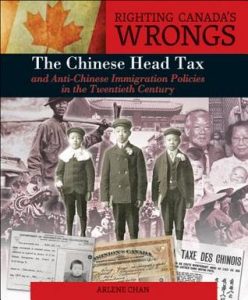
In fact, even historically, Canada was not immune. Have you heard about the Chinese head tax and the Chinese Exclusion Act (maybe you’ve heard of the American one, but what about the Canadian one that followed hot on its heels)? The one book we have specifically tackling the Chinese head tax & Chinese exclusion act in Canada: The Chinese Head Tax and Anti-Chinese Immigration Policies in the Twentieth-Century by Arlene Chan. The same author also wrote The Chinese Community in Toronto: Then and now.
Perhaps this doesn’t directly affect all Chinese people living in Canada – after all, these policies had a concrete beginning and end date, so anyone who immigrated to Canada after that time would have avoided that – but its effects are still felt today. As the interviewee, William Ging Wee Dere, notes, the nature of the reparations weren’t made in conversation with the affected, which brings to mind the mantra: Nothing about us without us. But it’s also not as though the anti-Chinese racism would just magically disappear overnight after the Chinese Exclusion Act was repealed either, and if the next question is well, hasn’t enough time passed that those attitudes no longer matter? The answer is still no, because intergenerational trauma (along with racist beliefs or attitudes) can be and is passed from one generation to the next. If you’re interested in learning more about Chinese Canadian history, here’s a brief chronology of Chinese Canadian history, along with the Canadian government’s official page on the history of early Chinese Canadians and more specifically about the Chinese Head Tax & Chinese Exclusion Act (HumanRights.ca).
*Just a note before I continue, I’m going to be using the term Asian American for the most part, but I also mean Asian Canadians. This article, Do all Asians look alike? by Robert Ho compares the model minority myth Asian Americans face and the Asian Canadian experience. (The link takes you directly to the pdf.)
** Second note before I continue: I unfortunately was unable to keep a copy of Minor Feelings on me as I wrote this post, so quotes have been taken from reviews where I was able to find them, and other points paraphrased as I was able to remember them. Hopefully it is clear throughout when I’ve done what.
Is Minor Feelings really the first collection of essays focusing on the Asian American experience that I’ve come across? I’ve read essay collections by Asian American authors, or at least one (Jia Tolentino’s Trick Mirror comes to mind – incidentally Tolentino reviewed Hong’s Minor Feelings for The New Yorker), but I cannot for the life of me think of another essay collection that addresses as frankly as Hong does in Minor Feelings what being (East) Asian in America is – or can be – like, and addresses what she calls “minor feelings,” calling out the internalization of the model minority myth along with the consequent complicity of upholding white supremacy by playing into the stereotype. What is a model minority, and why is it a myth? I’ll go over the myth part below, but briefly, the term “model minority” is used to “refer to a minority group perceived as particularly successful, especially in a manner that contrasts with other minority groups” (The Model Minority Myth, The Practice), for example, the economic success of Asian Americans (as a group; more on this later) contrasted against Black people (as in the New York Times article from 1966 that started it all, pitting Japanese Americans against Black Americans).
What Hong refers to as minor feelings was inspired by critical theorist Sianne Ngai’s “ugly feelings” (2005), which are “sustained undesirable emotions… also explicitly racialized, described by Hong as “emotions that are negative, dysphoric, and therefore untelegenic, built from the sediments of everyday racial experience and the irritant of having one’s perception of reality constantly questioned or dismissed”” (quoted from Cassie Packard’s review of Minor Feelings in the LA Review of Books). In an interview with Meghan O’Rourke from the Yale Review, Hong quotes this passage about minor feelings from her book:
Minor feelings occur when American optimism is forced upon you, which contradicts your own racialized reality, thereby creating a static of cognitive dissonance. You are told, ‘Things are so much better,’ while you think, Things are the same. You are told, ‘Asian Americans are so successful,’ while you feel like a failure.…When minor feelings are finally externalized, they are interpreted as hostile, ungrateful, jealous, depressing, and belligerent, affects ascribed to racialized behavior that whites consider out of line. Our feelings are overreactions because our lived experiences of structural inequity are not commensurate with their deluded reality (Hong, The Yale Review)
While I don’t identify with a lot of Hong’s personal experiences – a lot differs between me and Hong, so this should not be a surprise, from the generational difference, cultural difference (more on the flattening of the Asian American experience below), geographical, historical, political context differences – this might be the first time I’ve gotten a glimpse of what representation actually feels like. And in light of the (not-so-recent, given it’s been more than a year) uptick in anti-Asian violence, it feels increasingly important to hear Asian American voices, for one, but also to address the complications of being somewhere not white, but not Black either. As Elise Hu in an NPR review of Minor Feelings states, about Asian Americans being cast as a model minority: “[Hong] underlines the consequences of this role, in which we’re not the dominant whites, not the violently oppressed blacks, but instead struggle with “minor feelings” as we face the disorienting scripts written for Asians in American society: our “go along to get along” submissiveness and perpetual interchangeableness” (Hu, NPR). I would go one step further and say that this “submissiveness and perpetual interchangeableness” is part of what makes upholding the model minority myth problematic: to submit to the myth is to perpetuate inequality and uphold the white supremacy and xenophobia out of which this myth was built. But let’s move away for a moment from the model minority myth, because we’ll be coming back to that, and briefly touch on this “perpetual interchangeableness”. Hong discusses her ambivalence with using the term Asian American in her book to refer back to with the first person plural “we” in her interview with the Yale Review:
“Who is us” is a question that I grapple with in this book because Asian Americans are a tenuous alliance of so many different regions, nationalities, classes, sexualities, and genders. We’re so disparate. To write any kind of unifying definition of Asian American is going to get me into trouble… I want to know what is it that we have in common, too… How is that going to be weaponized so that we can fight injustice? Is it enough just to say, “We’re all different”? Yes, we’re different. And then what? (Hong, Yale Review)
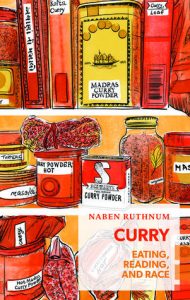 Similarly, in Curry: Eating, Reading and Race, Naben Ruthnum talks about the fear that the very act of writing as a racialized author will threaten to pigeonhole what narrative you have to say into the narrative the publishing industry wants to push, thinks will sell, given that the author is of the cultural background they’re from (whether that’s one or two or more generations removed, I’m not too sure the pigeonholing cares too much). As Ruthnum says, there’s nothing wrong with what he calls “curry books” (though he did note how when he went searching for the archetypal “curry book”, he actually had trouble finding one because what he had in mind was some amalgamation of all the common themes between all those different books he ended up reading: it was the archetypal currybook), so much as that there needs to be more variety of books written by Indian authors who are permitted to not fall into that category (and even then, who is doing the permitting?). And that’s not even mentioning the issue of marketing, regardless of whether the book itself falls within the monolithic narrative. A delightful dive into this is explored by Sanjena Sathian in Good Immigrant Novels (The Drift Mag).
Similarly, in Curry: Eating, Reading and Race, Naben Ruthnum talks about the fear that the very act of writing as a racialized author will threaten to pigeonhole what narrative you have to say into the narrative the publishing industry wants to push, thinks will sell, given that the author is of the cultural background they’re from (whether that’s one or two or more generations removed, I’m not too sure the pigeonholing cares too much). As Ruthnum says, there’s nothing wrong with what he calls “curry books” (though he did note how when he went searching for the archetypal “curry book”, he actually had trouble finding one because what he had in mind was some amalgamation of all the common themes between all those different books he ended up reading: it was the archetypal currybook), so much as that there needs to be more variety of books written by Indian authors who are permitted to not fall into that category (and even then, who is doing the permitting?). And that’s not even mentioning the issue of marketing, regardless of whether the book itself falls within the monolithic narrative. A delightful dive into this is explored by Sanjena Sathian in Good Immigrant Novels (The Drift Mag).
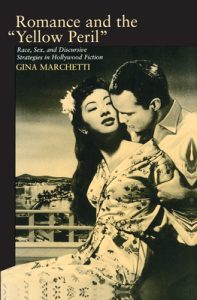 And while we’re on the topic of stereotyping, because that’s what it comes down to, isn’t it, when only certain narratives get published and reinforce a hegemonic storyline that drowns out all the complexity that comes of lived experiences? While we’re here, I also want to touch very briefly on the sexualization & fetishization of Asian women (and de-sexualization of Asian men; here’s an interesting article (accessible with VPL membership) focusing on where K-pop boy bands fall into this discussion), reinforced through media, and why regardless of whether the shooting in Atlanta was consciously driven by racial discrimination or not, the part where the shooter went to Asian-owned massage shops in order to remove what he perceived as temptation for his sex addiction would appear to meet quite plainly at the intersection between racism & sexism. In Romance and the “Yellow Peril” (more on the term on Wikipedia and The Conversation and CBC, just to throw a few sources out there), Marchetti uses various films to underscore the use of media to perpetuate harmful and flattening stereotypes about (East) Asians along with a narrow illustration of Asian-American dynamics/relationships.
And while we’re on the topic of stereotyping, because that’s what it comes down to, isn’t it, when only certain narratives get published and reinforce a hegemonic storyline that drowns out all the complexity that comes of lived experiences? While we’re here, I also want to touch very briefly on the sexualization & fetishization of Asian women (and de-sexualization of Asian men; here’s an interesting article (accessible with VPL membership) focusing on where K-pop boy bands fall into this discussion), reinforced through media, and why regardless of whether the shooting in Atlanta was consciously driven by racial discrimination or not, the part where the shooter went to Asian-owned massage shops in order to remove what he perceived as temptation for his sex addiction would appear to meet quite plainly at the intersection between racism & sexism. In Romance and the “Yellow Peril” (more on the term on Wikipedia and The Conversation and CBC, just to throw a few sources out there), Marchetti uses various films to underscore the use of media to perpetuate harmful and flattening stereotypes about (East) Asians along with a narrow illustration of Asian-American dynamics/relationships.
Besides which… the focus on whether or not one of those workers at the massage parlours targeted provided sex work or not strikes me as a diversionary tactic: what does it matter? Does it make the shooter’s crime any less terrible? As Nguyen from Red Canary Song states in an NPR article, “Say that one of those women was a sex worker, then is that person meant to be shamed in their death? Would they have deserved it? The answer is no.” This is a bit of an aside – but not really because it’s all interconnected regardless of the fact that there’s no evidence the victims of the shooting were involved in sex work – but March 3 was International Sex Workers’ Rights Day. We have one book from 2013, Selling Sex, that discusses sex work in Canada with a wider scope than solely focusing on human trafficking and underage sex work; the year of publication is actually quite interesting, because the laws around sex work were changed the year after, in 2014, under Bill C-36.
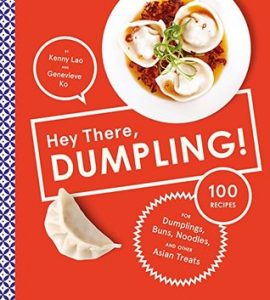 OK, so we’ve touched on the fetishization of Asian women, briefly – I think that one actually speaks for itself, so I won’t get too into why it’s harmful to stereotype Asian women as submissive & passive objects to be acted upon (Marchetti in Romance and the “Yellow Peril” goes into this more in full, including one section I found particularly interesting talking about the literally white knight and the use of the passive (Eur)Asian heroine that gives up her own identity for the male lead to contrast with the white woman who is the love rival but chooses independence and therefore loses the male hero) – but where does the model minority myth come in? (Note: that link will take you directly to a pdf hosted on the University of Washington server.) And why is it harmful? Again, the term model minority “has often been used to refer to a minority group perceived as particularly successful, especially in a manner that contrasts with other minority groups” (The Model Minority Myth, The Practice), which in North America is usually used to refer to Asian Americans for their “apparent success across academic, economic, and cultural domains—successes typically offered in contrast to the perceived achievements of other racial groups” (The Practice). Why is that a bad thing, you might ask? Asian food is ubiquitous, and there’s certainly no shortage of interest in Asian culture! Just look at all the cookbooks for Asian & Asian-inspired food we have, not to mention the konmari method, the trending of ikigai – evidently parts of Asian food and culture have become accepted into North American society not just as fringe aspects for those in the know but embraced by the mainstream (if potentially for its exoticism – I’m not going to get into it, but check out Edward Said’s Orientalism; also consider how despite the embrace of Asian food culture, they consistently end up on cheap eats lists, the expectations that are placed upon Asian-owned Asian restaurants (along with other non-European restaurant) to be cheap, and what that comes at the cost of – and the complicated picture this all exists in the context of). The implied question being: what more do you want? Or in Minor Feelings, as Hong retells her experiences with this: “Why are you pissed! You’re next in line to be white! As if we’re iPads queued up in an assembly line” (Hong, Minor Feelings, qtd from LA Review). Have I mentioned Hong’s dry humour?
OK, so we’ve touched on the fetishization of Asian women, briefly – I think that one actually speaks for itself, so I won’t get too into why it’s harmful to stereotype Asian women as submissive & passive objects to be acted upon (Marchetti in Romance and the “Yellow Peril” goes into this more in full, including one section I found particularly interesting talking about the literally white knight and the use of the passive (Eur)Asian heroine that gives up her own identity for the male lead to contrast with the white woman who is the love rival but chooses independence and therefore loses the male hero) – but where does the model minority myth come in? (Note: that link will take you directly to a pdf hosted on the University of Washington server.) And why is it harmful? Again, the term model minority “has often been used to refer to a minority group perceived as particularly successful, especially in a manner that contrasts with other minority groups” (The Model Minority Myth, The Practice), which in North America is usually used to refer to Asian Americans for their “apparent success across academic, economic, and cultural domains—successes typically offered in contrast to the perceived achievements of other racial groups” (The Practice). Why is that a bad thing, you might ask? Asian food is ubiquitous, and there’s certainly no shortage of interest in Asian culture! Just look at all the cookbooks for Asian & Asian-inspired food we have, not to mention the konmari method, the trending of ikigai – evidently parts of Asian food and culture have become accepted into North American society not just as fringe aspects for those in the know but embraced by the mainstream (if potentially for its exoticism – I’m not going to get into it, but check out Edward Said’s Orientalism; also consider how despite the embrace of Asian food culture, they consistently end up on cheap eats lists, the expectations that are placed upon Asian-owned Asian restaurants (along with other non-European restaurant) to be cheap, and what that comes at the cost of – and the complicated picture this all exists in the context of). The implied question being: what more do you want? Or in Minor Feelings, as Hong retells her experiences with this: “Why are you pissed! You’re next in line to be white! As if we’re iPads queued up in an assembly line” (Hong, Minor Feelings, qtd from LA Review). Have I mentioned Hong’s dry humour?
In Minor Feelings, Hong addresses the gaslighting of the lived Asian American experience directly (as seen in the above quotes about minor feelings), balancing out the acknowledgement that being Asian American affords certain privileges other minority groups don’t get in terms of socioeconomic advancement and status while also keeping an eye on the issues that are felt that Hong addresses throughout the book: “The lie that Asians have it good is so insidious that even now as I write, I’m shadowed by the thought that I didn’t have it bad compared to others. But racial trauma is not a competitive sport” (Hong, Minor Feelings, quoted from NPR Review). This NBC News article, The model minority myth says all Asians are successful. Why that’s dangerous, discusses how this perception of Asians as a group that is succeeding as a group culminates in, as Hong describes, the situation where “when minor feelings are finally externalized, they are interpreted as hostile, ungrateful, jealous, depressing, belligerent, affects ascribed to racialized behavior that whites consider out of line” (The Yale Review), how this plays out and the effects of this on the Asian American community (specifically with respect to anti-Asian racism & violence). The erasure, the silencing, is all a violence done to the Asian American community, but the truly insidious aspect is the internalization of the model minority myth such that you reinforce it yourself.
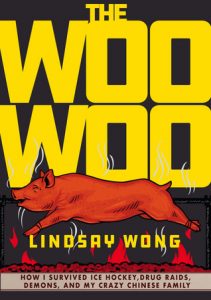 There’s a certain disconnect between your experience of reality and what you’re told (directly or indirectly through the internalization of the model minority myth) is happening. But if you’re part of the group that’s supposed to be excelling – “next in line” to be tucked into the fold of whiteness (does this just mean economically appear to stand on the same footing, or to have race no longer matter for Asians in America?), and you’re not: you don’t see yourself or are objectively not in that stereotypical academically & socioeconomically highly achieving, quiet role that doesn’t question the status quo (in order to maintain the precarious privilege that comes with more proximity to whiteness due to the categorization as being a “model minority” member) – where does that leave you? In the article Addressing the Stigma Associated with Seeking Help for Mental Health Among Asian Americans (accessible via Academic OneFile using your VPL card), the authors state “In addition to receiving less attention for their problems, the “model minority” identity also negatively affects the mindset of Asian Americans themselves. Studies show that Asian American students struggle with stress in meeting the high expectations placed on them by the stereotype, as it leaves no room for them to admit their problems (Inkelas, 2013; Sodowsky et al., 1995)”. But this enforced silence – from within or from without – is part of how the model minority myth continues to uphold systemic inequality, and playing into the myth by staying silent is to be complicit, to not only condemn yourself & other Asian Americans to never escape the myth and step into reality, but also to continue to perpetuate anti-Blackness.
There’s a certain disconnect between your experience of reality and what you’re told (directly or indirectly through the internalization of the model minority myth) is happening. But if you’re part of the group that’s supposed to be excelling – “next in line” to be tucked into the fold of whiteness (does this just mean economically appear to stand on the same footing, or to have race no longer matter for Asians in America?), and you’re not: you don’t see yourself or are objectively not in that stereotypical academically & socioeconomically highly achieving, quiet role that doesn’t question the status quo (in order to maintain the precarious privilege that comes with more proximity to whiteness due to the categorization as being a “model minority” member) – where does that leave you? In the article Addressing the Stigma Associated with Seeking Help for Mental Health Among Asian Americans (accessible via Academic OneFile using your VPL card), the authors state “In addition to receiving less attention for their problems, the “model minority” identity also negatively affects the mindset of Asian Americans themselves. Studies show that Asian American students struggle with stress in meeting the high expectations placed on them by the stereotype, as it leaves no room for them to admit their problems (Inkelas, 2013; Sodowsky et al., 1995)”. But this enforced silence – from within or from without – is part of how the model minority myth continues to uphold systemic inequality, and playing into the myth by staying silent is to be complicit, to not only condemn yourself & other Asian Americans to never escape the myth and step into reality, but also to continue to perpetuate anti-Blackness.
Does that seem like I just made a leap?
Since last year, I’ve seen a lot more discourse – or at least awareness-raising – around why the model minority myth isn’t flattering: it’s dangerous, flattening out individual circumstances & pushing the illusion of a society that is purely a meritocracy. The model minority myth shoves all those who fall under the group umbrella of “Asian American” (or Asian Canadian) into the same category, despite the fact that a great variety of cultural variation exists therein, and pits Asian Americans against other minority groups, put on a pedestal to make the argument that well, clearly, Asian Americans are successful because they put in the work; its corollary being that evidently, Black populations, Latinx populations, etc., simply aren’t working hard enough to overcome systemic racism and succeed. And although the term “model minority” only gained popular use in the 1960s, the model minority myth is still going strong. A number of issues here, but let’s go through a couple of the more glaring ones:
- This group umbrella term, Asian American, while it does have its history in activism and was an improvement on what was in place before, lumps together a great number of people of vastly different backgrounds, not all of whom find success at the same rate in North American society. In fact, according to the Pew Research Centre, although when considered as one category, Asians are the highest earning racial group in the U.S., “In 2016, Asians at the 90th percentile of their income distribution had 10.7 times the income of Asians at the 10th percentile. The 90/10 ratio among Asians was notably greater than the ratio among blacks (9.8), whites (7.8) and Hispanics (7.8)(Pew Research Centre). (This New York Times article also talks about the Pew findings.)
- I think this goes without saying, as with any stereotyping does, that this does a disservice to everyone, flattening all who fall into the group and erasing their individuality
- Is it time to start using another term though? There are arguments for and against doing so
- From the start, the idea of a model minority has been used to contrast Asian Americans, specifically the Japanese in the New York Times article that started it all, against Black populations, and fuel the fantasy of America as a post-racial meritocracy where systemic racism doesn’t exist
- From the L.A. Times article linked above in #1: “Moreover, critics disliked the ways in which ideas about Asian Americans reinforced the denigration of African Americans. Writing for Los Angeles-based Gidra magazine in 1969, Amy Uyematsu resented being implicated in “white racism” by being “held up” before other minority groups as a “model to emulate.”” (Wu, Asian Americans and the ‘Model Minority’ Myth, 2014)
- Part of the myth is that the reason Asian Americans are successful (economically) in North American society is because of their hard work (less often voiced directly, that they work hard enough to succeed despite racism). Which implies other oppressed minority groups are simply not working hard enough (to overcome systemic racism, if that is addressed at all), but all this sustains the myth of us being in a post-racial meritocracy in America (Mediocre by Ijeoma Oluo is a delightful read; The Tyranny of Merit by Michael J. Sandel is on my to-read list, but I’ll include it here since it’s related)
- I mean, personally, I think the obvious line of questioning that follows from even just typing out what I did is: But why should anyone have to succeed in spite of systemic racism?
All this brings us back to where we were a little over one year ago: anti-racism. Here’s an interview article from the Huffington Post about anti-Blackness in the Chinese Canadian community, and addresses the conscious rejection of the model minority myth as one of the things that can be done by Chinese Canadians (and Asian Canadians more generally): “Some tactics folks in Chinese Canadian communities can use is to understand and reject the model minority myth and its ability to be weaponized against Black and Brown communities… and also reading about Black and Indigenous histories in Canada. We need to reflect on our many structural privileges and marginalizations and hold space for those complexities” (Wong, If You Hate Anti-Chinese Racism, You Should Hate Anti-Black Racism, Too). Another enlightening article that centres the South Asian Canadian community, Searching for anti-racism agendas in South Asian Canadian communities, from The Conversation, also tackles how any anti-racism discussions must take place with the understanding of the complexities stretching beyond a white-Black binary, noting “racism can sometimes be treated by racialized immigrants as a white settler-Indigenous-Black triad. But critical race scholarship warns that we must not perpetuate Indigenous and settlers as a binary or opposite” (Bhutani & Tenneti, The Conversation).
I’m going to end this post off here, but if you’re interested in the titles I’ve mentioned throughout the post, as well as other related reads and books by Asian authors, feel free to either click on the links throughout the post (or book covers), or take a look at this list:
- Check out our monthly Reflecting on Racism & Discrimination online lecture series on Eventbrite! This month our guest speaker will be discussing the impacts of systemic racism. These workshops are free to sign up for and cover different subjects every month with a guest speaker.
- Minor Feelings is available on Overdrive as an e-book and an e-audiobook
- Know My Name by Chanel Miller (also available on Overdrive as an e-book and an e-audiobook)
- Romance and the “Yellow Peril”: Race, Sex and Discursive Strategies in Hollywood Fiction by Gina Marchetti
- Curry: Eating, Reading and Race by Naben Ruthnum
- As Alyssia mentioned in her Canada Reads post, there’s Two Trees Make a Forest written by Jessica J. Lee, available on Overdrive as an e-book and e-audiobook
- The Woo-Woo: How I survived ice hockey, drug raids, demons, and my crazy Chinese family by Lindsay Wong was a 2019 Canada Reads contender is available on Overdrive and Hoopla Digital as an e-book
- The Chinese Head Tax and Anti-Chinese Immigration Policies in the Twentieth-Century by Arlene Chan
- Good Talk: A memoir in conversations by Mira Jacob is told in graphic novel format, told through conversations Jacob has with her 6-year old Indian-Jewish son. It’s also available on Overdrive as an e-book.
- Missed Translations: Meeting the immigrant parents who raised me by Sopan Deb (Indian American)
- I really enjoyed The Color of Air by Gail Tsukiyama
- And of course, check out these lists by VPL staff: Celebrate Asian Authors and Teen Reads: Authors and Stories for Asian Heritage Month
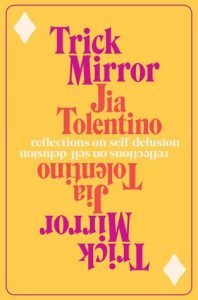
Wow this post left me with a lot more reading to do! I really appreciated how you were able to incorporate so many resources and concepts into one post. Thanks for sharing your thoughts on Minor Feelings, it’s definitely going up the reading list!
Thank you! I know I can only capture so much in one post, but hopefully it’s a good jumping off point.
Something I found out kind of late in the game and didn’t add to the post: Minor Feelings is getting an adaptation written by and starring Greta Lee! I’m super excited for whenever it comes out 😀